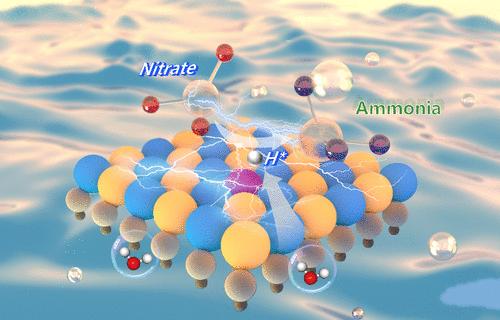Single-Atom Cu and Zn Vacancy Synergy in NiFe-LDH Boosts Metal–Support Interaction for High-Efficiency Nitrate-to-Ammonia Electroreduction
IF 11.3
1区 环境科学与生态学
Q1 ENGINEERING, ENVIRONMENTAL
引用次数: 0
Abstract
The electrochemical nitrate (NO3-)-to-ammonia conversion reaction (NO3RR) represents a transformative approach addressing dual challenges of environmental remediation and sustainable ammonia (NH3) synthesis. Despite its promise, practical implementation remains constrained by parasitic hydrogen evolution and inherent kinetic limitations. We propose an innovative dual-site architecture through atomic-scale metal–support engineering, constructing single copper (Cu) atoms anchored on zinc-deficient NiFe-layered double hydroxide (CuSA/V-LDH). This strategic design achieves exceptional NO3RR performance, delivering 95.2% Faradaic efficiency and 2.08 mg h–1 cm–2 NH3 yield at environmentally relevant NO3- levels (100 mg-N L–1), surpassing most reported catalysts in low-concentration scenarios. Operando spectroscopy and multiscale modeling uncover key synergistic effects that govern the system’s enhanced performance. Vacancy-mediated charge redistribution strengthens metal–support interactions and structural durability, while LDH-derived atomic hydrogen species exhibit prolonged lifetimes through CuSA coordination, which facilitates efficient hydrogenation of nitrogen intermediates. Additionally, the flow-through reactor configuration optimizes mass transport, further boosting the overall reaction kinetics. System-level validation and life cycle assessment highlight the reduced environmental footprint of the proposed technology. This work establishes a paradigm for vacancy-engineered atomic interfaces in advanced electrocatalytic systems in circular water–energy nexus applications.

NiFe-LDH中单原子Cu和Zn空位协同作用促进了金属-载体相互作用对高效硝酸盐-氨电还原的影响
电化学硝酸(NO3-)-氨转化反应(NO3RR)代表了解决环境修复和可持续氨(NH3)合成双重挑战的变革性方法。尽管前景看好,但实际实施仍然受到寄生氢演化和固有动力学限制的制约。我们通过原子尺度的金属支撑工程提出了一种创新的双位点结构,将单个铜(Cu)原子锚定在缺锌的nife层状双氢氧化物(CuSA/V-LDH)上。该战略设计实现了卓越的NO3RR性能,在与环境相关的NO3-水平(100 mg- n - 1)下,具有95.2%的法拉第效率和2.08 mg h-1 cm-2 NH3产率,超过了大多数低浓度情况下报道的催化剂。Operando光谱和多尺度建模揭示了控制系统增强性能的关键协同效应。空位介导的电荷重分配增强了金属-载体相互作用和结构耐久性,而ldh衍生的原子氢通过CuSA配位表现出更长的寿命,这有利于氮中间体的有效加氢。此外,流动反应器配置优化了质量传输,进一步提高了整体反应动力学。系统级验证和生命周期评估强调了拟议技术减少的环境足迹。这项工作建立了一个范例的空缺工程原子界面在先进的电催化系统在循环水能联系应用。
本文章由计算机程序翻译,如有差异,请以英文原文为准。
求助全文
约1分钟内获得全文
求助全文
来源期刊

环境科学与技术
环境科学-工程:环境
CiteScore
17.50
自引率
9.60%
发文量
12359
审稿时长
2.8 months
期刊介绍:
Environmental Science & Technology (ES&T) is a co-sponsored academic and technical magazine by the Hubei Provincial Environmental Protection Bureau and the Hubei Provincial Academy of Environmental Sciences.
Environmental Science & Technology (ES&T) holds the status of Chinese core journals, scientific papers source journals of China, Chinese Science Citation Database source journals, and Chinese Academic Journal Comprehensive Evaluation Database source journals. This publication focuses on the academic field of environmental protection, featuring articles related to environmental protection and technical advancements.
 求助内容:
求助内容: 应助结果提醒方式:
应助结果提醒方式:


